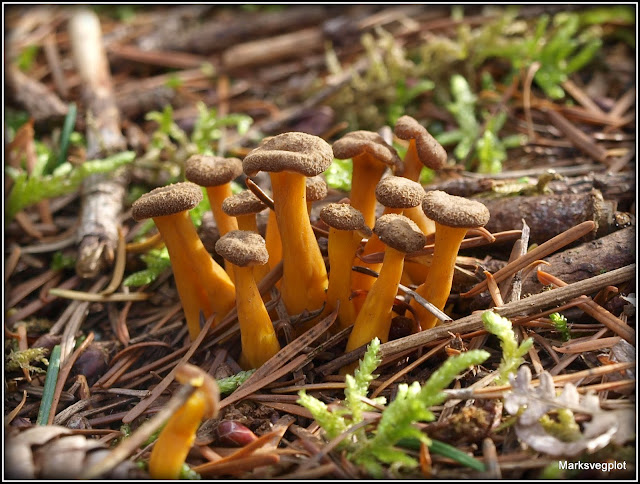Most of the edible fungi are ones which appear in the Summer and early Autumn. Not all of course, because during Winter you still get the Velvet Shanks (Flammulina velutipes), Blewits (Lepista spp), Wood Ears (Auricularia auricula-judae) and even the occasional Oyster Mushrooms (Pleurotus ostreatus). That said, however, Winter is usually the season for the fungi that are more for looking than for cooking - like the crusts and jellies. Incidentally, my definition of what constitutes a jelly fungus is definitely a subjective one!
Over the last couple of weeks I have been lucky enough to find quite a wide variety of jelly fungi. Perhaps the most striking is the Yellow Brain fungus, Tremella mesenterica, sometimes called Witches' Butter.
 |
| Tremella mesenterica growing on living Gorse |
Although it grows on the (usually dead) wood of a variety of broadleaf trees, his highly visible fungus has a particular liking for Gorse bushes, either living or dead.
 |
| Tremella mesenterica growing on fallen (dead) Gorse wood |
 |
| Tremella mesenterica growing on fallen Beech wood |
To be pedantic, the Tremella does not really grow on the wood, but it feeds on another fungus by which that wood has been attacked. This is usually Peniophora incarnata, commonly known as the Rosy Crust fungus.
The best time to see Yellow Brain is in the Winter, particularly if the weather is wet. In dry weather the fungus shrinks and darkens, making it more difficult to spot. This photo taken a few weeks ago shows one which is very orange in colour, so it was probably just beginning to re-hydrate after the long dry Summer.
My next subject is Tremella foliacea, Leafy Brain. [I note however that if you want to be really accurate the name Tremalla foliacea is supposedly only used for the species that grows on conifer wood, whereas Tremella frondosa is the one that grows on broadleaf wood. Most people lump them together!]
The example I saw this week was growing on a small Oak tree, so I suppose it is technically Tremella frondosa.
About this time last year I saw a much bigger example in the woods just half a mile from our house, and this one was also growing on a young Oak. It was a multi-coloured specimen, which I think indicates growth in a number of different stages.
I believe that the lighter part is probably the youngest part, because other, very dark, specimens I have seen have appeared to be very old and ragged.
Like its cousin Tremella mesenterica, Tremella foliacea grows on wood that has been attacked by another fungus, in this case the wood-rotting fungus Stereum hirsutum, commonly referred to by the lovely name Hairy Curtain Crust.
I'll move now to the fungus called Ascocoryne sarcoides, commonly known as Purple Jellydisc. As I have found recently, this fungus goes through a number of stages during its lifecycle and can look quite different at each stage. I'm not going to attempt to describe these in scientific terms, because I am assuming that my readers are probably (like me) just enthusiastic amateurs, so let me just say that when young this fungus often looks slimy and ill-defined. In one of the Facebook Groups to which I belong this is often referred to as "Mouse Guts Fungus"!
Later on it seems to get firmer and it develops into more structured "blobs".
You'll notice that in the preceding two photos the fungus has a definite purple colour. When it grows older it turns more of a red colour, and tends to form flatter fruitbodies, like this:
In the past this has confused me. I had thought that this was a different fungus but friends in my Facebook Groups have confirmed that it's the same one.
Ascocoryne sarcoides grows predominantly on well-rotted broadleaf wood. I see it most often on Birch - though that is probably because there are loads of Birch trees in my area.
 |
| Ascocoryne sarcoides on very old Birch wood. |
This post could go on for a long time, but today I want to cover only one more fungus, which is Bulgaria inquinans - Black Bulgar - aka Bachelor's Buttons or Poor Man's Liquorice.
This fungus usually forms fairly regular fruitbodies, which are broadly circular and cup-shaped, with flat upper surfaces. These upper surfaces (the fertile surfaces) are black and shiny, whereas the sides are usually brown and felty.
As with most fungi of this nature, Black Bulgar is softer and more jelly-like in wet weather and it is firmer when the weather is dry. Its preferred habitat is fallen broadleaf wood, such as this pile of Beech logs.
Look closely and you'll see that the logs are covered with hundreds of little black blobs...
There are literally dozens of other jelly fungi that I could describe, and I have been fortunate enough to find plenty of them, but I want to stop here. If you are interested to learn more I strongly recommend having a look at the relevant part of the First Nature website. In a future post I will cover some of the so-called Crust fungi.


























































